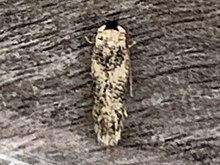
The American chestnut is a large, fast-growing deciduous tree of the beech family native to eastern North America. As is true of all species in the genus Castanea, the American chestnut produces burred fruit with edible nuts. The American chestnut was once one of the most important forest trees throughout its range.

Fraxinus americana, the white ash or American ash, is a fast-growing species of ash tree native to eastern and central North America.

Quercus muehlenbergii, the chinquapinoak, is a deciduous species of tree in the white oak group. The species was often called Quercus acuminata in older literature. Quercus muehlenbergii is native to eastern and central North America. It ranges from Vermont to Minnesota, south to the Florida panhandle, and west to New Mexico in the United States. In Canada it is only found in southern Ontario, and in Mexico it ranges from Coahuila south to Hidalgo.

Quercus coccinea, the scarlet oak, is a deciduous tree in the red oak section Lobatae of the genus Quercus, in the family Fagaceae.
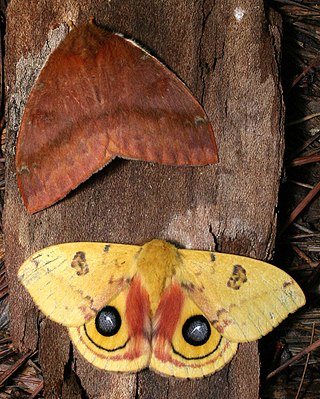
Automeris io, the Io moth or peacock moth, is a colorful North American moth in the family Saturniidae. The Io moth is also a member of the subfamily Hemileucinae. The name Io comes from Greek mythology in which Io was a mortal lover of Zeus. The Io moth ranges from the southeast corner of Manitoba and in the southern extremes of Ontario, Quebec, New Brunswick and Nova Scotia in Canada, and in the US it is found from Montana, North Dakota, South Dakota, Nebraska, Colorado, New Mexico, Texas, Utah, east of those states and down to the southern end of Florida. The species was first described by Johan Christian Fabricius in 1775.

Nepticulidae is a family of very small moths with a worldwide distribution. They are characterised by eyecaps over the eyes. These pigmy moths or midget moths, as they are commonly known, include the smallest of all living moths, with a wingspan that can be as little as 3 mm in the case of the European pigmy sorrel moth, but more usually 3.5–10 mm. The wings of adult moths are narrow and lanceolate, sometimes with metallic markings, and with the venation very simplified compared to most other moths.
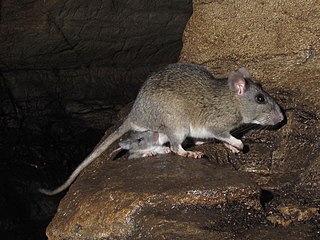
The Allegheny woodrat, is a species of "pack rat" in the genus Neotoma. Once believed to be a subspecies of the eastern woodrat, extensive DNA analysis has proven it to be a distinct species.

A species that is extinct in the wild (EW) is one that has been categorized by the International Union for Conservation of Nature as only consisting of living members kept in captivity or as a naturalized population outside its historic range. Classification requires exhaustive surveys conducted within the species' known habitat with consideration given to seasonality, time of day, and life cycle. Once a species is classified as EW, the only way for it to be downgraded is through reintroduction.

The chestnut ermine moth is an extinct species of moth in the subfamily Argyresthiinae. It was endemic to the United States. The species was only seen in two states, New Hampshire and Vermont. It became extinct due to chestnut blight obliterating its primary food source, the American chestnut.
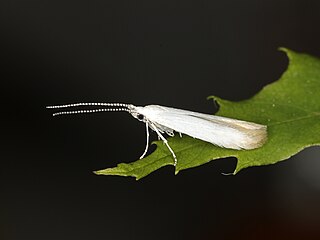
The chestnut casebearer moth is a species of moth in the family Coleophoridae. It is endemic to the United States, where it is found in Indiana, Massachusetts, Pennsylvania, and Virginia. It is a highly specialized species, its larvae feed specifically on the leaves of the American Chestnut. It was thought the species became extinct when many American chestnut trees died due to an infection of the fungus Cryphonectria parasitica, which was accidentally introduced from Asia around 1900. However, this species was rediscovered.
The Phleophagan Chestnut Moth was a species of moth in the Nepticulidae family. It was endemic to the United States, where it was known from Virginia.

Betula uber, the Virginia round-leaf birch, is a rare species of tree in the birch family. One of the most endangered species of North American trees, it is endemic to Smyth County, in the U.S. state of Virginia. It is part of the temperate broadleaf and mixed forests biome.

Papilio aristodemus, the Schaus' swallowtail or island swallowtail, is a species of American butterfly in the family Papilionidae. It is found in southern Florida in the United States and throughout the West Indies. It is named in honor of William Schaus.
The poplar petiole gall moth is a moth of the family Nepticulidae. It is widely distributed in North America east of the Rocky Mountains. It was first described by Danish-American entomologist August Busck in 1907.

Ectoedemia minimella is a moth of the family Nepticulidae. It is widely distributed in the Holarctic.
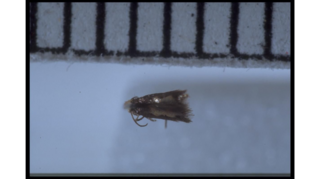
Stigmella aigialeia is a moth of the family Nepticulidae. It is endemic to New Zealand and can be found on both the North and South Islands. The larvae of this species are leaf miners and are known to feed on the leaves of Plagianthus divaricatus. Larvae have been recorded as feeding in April, May and September. They pupate in leaf litter on the ground under their host plant. Adults of this have been observed on the wing in January, February, September and October, in coastal locations particularly in the preferred habitat of its host plant, that is salt marshes and sandbanks.
Stigmella hakekeae is a moth of the family Nepticulidae. It is endemic to New Zealand and is found in the North, South and Stewart Islands. The larvae feed on Olearia species and are leaf miners. This species pupates in a silk cocoon on the ground underneath its host plant. Adults are on the wing most months of year except for March and April. They have been observed flying during the day near their host plant. There are four or five generations per year. This species is regarded as being widely distributed and locally abundant.

Stigmella hoheriae is a species of moth of the family Nepticulidae. This day flying moth is found in New Zealand in both the North and South Islands. It inhabits native forest. Eggs are laid on the surface of a still growing leaf of a host plant. Larvae feed on Hoheria species such as Hoheria glabrata, Hoheria populnea, Hoheria sexstylosa and Hoheria angustifolia and have been recorded from February to August. The larvae of S. hoheriae are leaf miners. Their mines create blotches on the host plant leaves. S. hoheriae larvae pupate in a silk cocoon on the ground at the base of their food plant. Adult moths have been observed on the wing in February and from July to December. This species is rarely noticed as it is very small and as a result does not tend to attract attention when on the wing.

Stigmella ilsea is a moth of the family Nepticulidae. It is endemic to New Zealand and has been observed in the North and South Islands. The larvae of this species are leaf miners and feed on Olearia virgata, Olearia rugosa, Olearia odorata, Olearia laxiflora, Olearia lineate and Olearia hectorii. Adult moths have been recorded in January, October and November. Reared specimens emerged from July to September. There is likely one generation per year.
